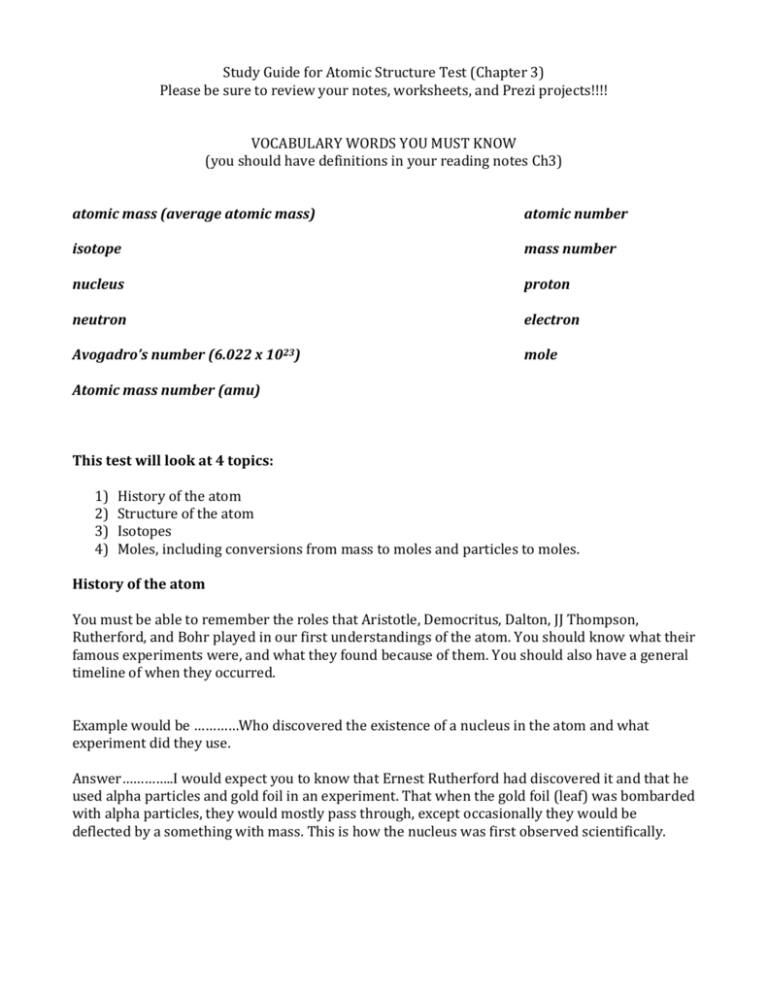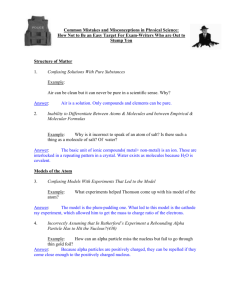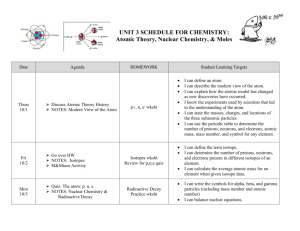Study Guide for the test on CH3
advertisement

Study Guide for Atomic Structure Test (Chapter 3) Please be sure to review your notes, worksheets, and Prezi projects!!!! VOCABULARY WORDS YOU MUST KNOW (you should have definitions in your reading notes Ch3) atomic mass (average atomic mass) atomic number isotope mass number nucleus proton neutron electron Avogadro’s number (6.022 x 1023) mole Atomic mass number (amu) This test will look at 4 topics: 1) 2) 3) 4) History of the atom Structure of the atom Isotopes Moles, including conversions from mass to moles and particles to moles. History of the atom You must be able to remember the roles that Aristotle, Democritus, Dalton, JJ Thompson, Rutherford, and Bohr played in our first understandings of the atom. You should know what their famous experiments were, and what they found because of them. You should also have a general timeline of when they occurred. Example would be …………Who discovered the existence of a nucleus in the atom and what experiment did they use. Answer…………..I would expect you to know that Ernest Rutherford had discovered it and that he used alpha particles and gold foil in an experiment. That when the gold foil (leaf) was bombarded with alpha particles, they would mostly pass through, except occasionally they would be deflected by a something with mass. This is how the nucleus was first observed scientifically. Structure of the atom I expect everyone to be able to show their knowledge of the subatomic particle that make up an atom; proton, neutron, and electron. You need to be able to tell me their charge and amu (atomic mass numbers). You should also know where they exist in an atom, ie neutron and proton in the nucleus. When presented with problems you need to be able to tell me how many proton neutrons and electron are in an element or isotope based on limited information, such as: If I give you the hyphen notation or nuclear symbol of an uranium isotope you should be able to tell me how many protons, neutrons, and electrons are in that atom Uranium-238 =protons) 92 protons ( from periodic table) 92 electrons (because electrons 146 neutrons (remaining mass after protons are subtracted) Isotopes Remember isotopes are just atoms of elements that have different numbers of neutrons. Isotopes do not have different properties other than mass. Be careful to recall that number of protons determine an element not neutrons. Since neutrons exist we must be able to determine their abundance and take them into account in our atomic mass. You will need to be able to determine the average atomic mass by calculating the percent abundance of isotopes of different elements. Remember to do this you must: 1) Determine the mass of each isotope and its percent abundance 2) Take the percent and put it into a decimal percentage (divide it by 100) 3) multiply the mass of the isotopes by their decimal percentages 4) add them up and this should be the average atomic mass of the element Moles So, we will be using the mole the rest of the year, remember the mole is a unit. Just like we say a dozen for units of twelve, we say mole for 6.022 x 1023 of something. The mole helps us convert molecules or atoms into mass (grams). Please look over you notes on and the figure 11 in chapter three to help visualize how we convert between the three.










